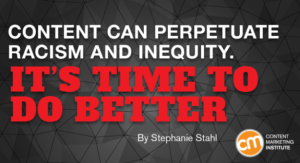In a world grappling with a global pandemic, economic shutdown and social injustice, marketers are challenged more than ever to develop thoughtful approaches and meaningful communications that speak to the needs and concerns of customers, investors, influencers, and employees.
Recently, we’ve seen myriad posts, webinars and other useful resources that can help inform go-forward content strategies and development. Looking across the board, some recurring themes emerge. There’s a renewed emphasis on writing with empathy, authenticity, and transparency; collaboration, active listening and a willingness to learn, and an ability to back up well-crafted words with consistent action.
Here are just a few assets that our team found valuable – take a look:
Applied learnings.
 The History Factory’s COVID-19 Corporate Memory Project is an online resource center capturing COVID-19 related employer content. For many of us, learning from others’ experiences, particularly beacon brands, brings the conceptual to life. The History Factory has curated content shared by more than 300 firms – including Fortune 500 companies, the top 100 privately held companies and 50 of the largest trade associations in the U.S., along with publicly available digital, social and media content. To help you find the most relevant content, it’s organized by Collection (e.g., Leading in a Crisis; Service and Community) or by industry.
The History Factory’s COVID-19 Corporate Memory Project is an online resource center capturing COVID-19 related employer content. For many of us, learning from others’ experiences, particularly beacon brands, brings the conceptual to life. The History Factory has curated content shared by more than 300 firms – including Fortune 500 companies, the top 100 privately held companies and 50 of the largest trade associations in the U.S., along with publicly available digital, social and media content. To help you find the most relevant content, it’s organized by Collection (e.g., Leading in a Crisis; Service and Community) or by industry.
The crowd-sourced repository gives organizations an opportunity to learn how others have responded to the challenges the pandemic and phased re-opening has presented. And ideally, lessons learned from this crisis can help business leaders drive strategy and planning going forward.
Source of Pride.
 June is Pride Month. An NBC News report offers valuable perspective on Pride 2020: How LGBTQ Pride Month went from movement to marketing and the impact – both good and bad – of that evolution. Some question the level of brand commitment; does it go beyond the superficial show of support (i.e., “rainbow washing?”)
June is Pride Month. An NBC News report offers valuable perspective on Pride 2020: How LGBTQ Pride Month went from movement to marketing and the impact – both good and bad – of that evolution. Some question the level of brand commitment; does it go beyond the superficial show of support (i.e., “rainbow washing?”)
Digital Marketer provides practical do’s and don’ts to effectively celebrate and support the LGBTQ+ community in its Guide to Pride Month Marketing. Both pieces stress authenticity and striking the right balance so that brand efforts remain more about inclusivity and less about commercialization.
Be part of the solution.
 As CMI General Manager Stephanie Stahl so eloquently put it, “We as content marketers need to do better. We must ensure that our content authentically reflects the diverse voices and experiences of our audiences and avoids unconscious bias. If we don’t, we are contributing to the problem.” Her post suggests how to evaluate your content for appropriateness and, longer term, what you can do to address diversity and inclusion in your content and your organization. In other words, how we can do better.
As CMI General Manager Stephanie Stahl so eloquently put it, “We as content marketers need to do better. We must ensure that our content authentically reflects the diverse voices and experiences of our audiences and avoids unconscious bias. If we don’t, we are contributing to the problem.” Her post suggests how to evaluate your content for appropriateness and, longer term, what you can do to address diversity and inclusion in your content and your organization. In other words, how we can do better.
YPulse reports on lessons from the brand response to #BlackLivesMatter. Again, actions speak volumes and consumers (particularly Millennials and Gen Z) are looking for brands to go beyond platitudes – and get specific about what they’re going to do. And those same consumers will then hold brands accountable to deliver.

Principal
Engaging your customers is at the heart of successful marketing programs. For more than 20 years, Cheryl has been building and executing content and thought leadership strategies designed to do just that. She is excited to be applying that well-honed skill to a help companies like Microsoft, Cisco, 3M, Intel, Capital One and Barclaycard tap into their stakeholder communities and build sophisticated content strategies.
Her experience base spans a range of industries – from technology and financial services to retail, travel, consumer products and healthcare. Cheryl has served as an integral member of her clients’ marketing teams, providing counsel on marketing and brand strategy, thought leadership, media relations, product introductions, and event management.
Prior to joining ComBlu, Cheryl spent 10 years leading corporate marketing for large, complex organizations.

